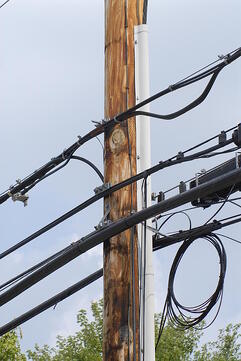The Wonderful Wood Utility Pole: History and Benefits
 Utility poles come in a variety of materials from metal to concrete to composites such as fiberglass, however, we would like to turn our attention to—and delve into the details of—perhaps the most prevalent type of pole in use today: the treated wood pole.
Utility poles come in a variety of materials from metal to concrete to composites such as fiberglass, however, we would like to turn our attention to—and delve into the details of—perhaps the most prevalent type of pole in use today: the treated wood pole.
The ubiquitous treated wood utility pole has brought
power and communications to American homes and businesses for more than a century. They are so common actually, according to the North American Wood Pole Council, in the face of newer, more high-tech options; the natural wood pole is sometimes overlooked and underappreciated for its durability, longevity and cost-effectiveness.[1]
So, today we celebrate our favorite arrow-straight
structures with a Top 5 List of Benefits:
5. Wooden Poles Made Life More Livable
Before the advent of the widely used wooden power pole, our country was quite literally in the “dark” ages. The revolution started with a failed experiment in running underground telegraph lines. In 1844, with a grant from Congress, Samuel Morse began burying line between Baltimore, MD and Washington, D.C. Unfortunately, the experiment was a failure—the cable did not reliably carry a signal. As a remedy, Morse strung it on poles overhead.[2] When home delivery of electricity became the norm, wooden poles made the most sense for distribution. When mass communication and entertainment was born, the infrastructure was tapped to support that too. The result: a societal boom the likes of which we have not seen since. With electric light and high-speed communication—telephone to internet—every aspect of society advanced, from science to healthcare, the arts to invention.
4. Wooden Poles Are a Bargain (Relatively Speaking)
While exact pole prices vary by producer, in general, when you think about the means of production behind a wooden pole, rather than the sourcing of materials, labor, manufacturing and other costs associated with creating a pole from scratch, soil, air, sun, water and the magic of nature are pretty economical. Additionally, a recent life cycle analysis of all typical alternatives that considered longevity, maintenance, hardware and disposal — concluded, “for most overhead line applications, treated wood remains the most cost-effective material in terms of initial and total life-cycle costs.”[3]
3. Wooden Poles are Naturally Resilient
Nature gave trees a solid advantage in terms of withstanding wind and weather. Wood is strong and has a low thermal expansion coefficient and a low conductivity rating, meaning millions of years of evolution has created a thermally stable product that does not corrode, and with a little help from man-made treatment products, can even shake off natural enemies like bugs and fungus.
2. Production of Wooden Poles is Responsive and Scalable
Over the last decade, pole producers have proven themselves time and again to be able to quickly meet fluctuating demand for their product, especially in the wake of emergency situations that tax all infrastructure such as hurricanes and tornadoes. Some plants produce more than 400 poles per day, and in combination will have poles rolling off the line in huge numbers when needed. After Hurricane Katrina, 92,000 wooden poles were delivered to weather-ravaged Louisiana in about four weeks. After Hurricane Sandy, over 65,000 poles were produced in short order.[4]
1. Wood is A Renewable Resource
It truly does not get any greener than using a natural material like wood. Trees grown through managed timberland have a long history of sustainability. Growing trees produces oxygen, stores carbon and helps limit the accumulation of greenhouse gases. Decommissioned poles are recycled in a number of ways. The utility pole industry also does its part. In January 2014, the Electric Utility Industry Sustainable Supply Chain Alliance produced a seminal report detailing sustainable regarding wood pole manufacturing, purchasing, management and disposal/reuse, setting a benchmark for the industry.[5]
In short, wooden utility poles do a lot for our society as a whole and remain a cost-effective means of delivering the many varied services we crave.
[1] http://www.woodpoles.org/documents/Ten_features_of_wood_poles.pdf
[2] http://en.wikipedia.org/wiki/Utility_pole#History
[3] Utility Structure Competitive Products Report Series, Report No. 5 “Life Cycle Economics” prepared by Engineering Data Management, Inc. 1997
[4] http://www.woodpoles.org/documents/Ten_features_of_wood_poles.pdf
[5] http://tdworld.com/energizing/electric-utility-industry-alliance-unveils-new-wood-pole-sustainable-practices
